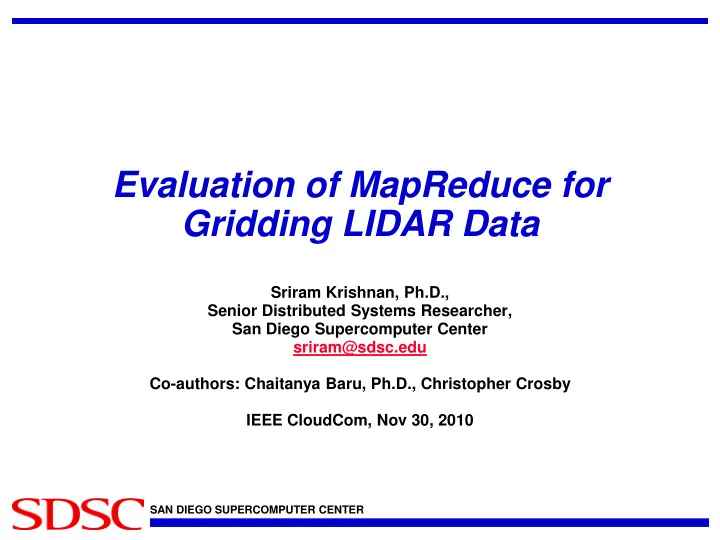

Evaluation of MapReduce for Gridding LIDAR Data Sriram Krishnan, Ph.D., Senior Distributed Systems Researcher, San Diego Supercomputer Center sriram@sdsc.edu Co-authors: Chaitanya Baru, Ph.D., Christopher Crosby IEEE CloudCom, Nov 30, 2010 SAN DIEGO SUPERCOMPUTER CENTER
Talk Outline • Overview of OpenTopography & LIDAR • Introduction to Digital Elevation Models (DEM) • DEM Algorithm Overview • C++ and Hadoop Implementation Details • Performance Evaluation • Discussion & Conclusions SAN DIEGO SUPERCOMPUTER CENTER
The OpenTopography Facility • High resolution topographic data: http://www.opentopography.org/ • Airborne • Terrestrial* SAN DIEGO SUPERCOMPUTER CENTER
Introduction to LIDAR • LIDAR: Light, Detection, and Ranging • Massive amounts of data • Real challenge to manage and process these datasets Waveform Data D. Harding, Full-featured NASA DEM Portal Bare earth DEM Point Cloud Dataset SAN DIEGO SUPERCOMPUTER CENTER
Digital Elevation Models (DEM) • Digital continuous representation of the landscape • Each (X, Y) is represented by a single elevation value (Z) • Also known as Digital Terrain Models (DTM) • Useful for a range of science and engineering applications • Hydrological Modeling, Terrain Analysis, Infrastructure Design Mapping of non-regular LIDAR returns into a regularized grid* SAN DIEGO SUPERCOMPUTER CENTER
DEM Generation: Local Binning Full-featured DEM Bare earth DEM SAN DIEGO SUPERCOMPUTER CENTER
C++ In-Core Implementation O(N) O(G) SAN DIEGO SUPERCOMPUTER CENTER
C++ Out-of-Core Implementation • Sorted • Input read: O(N) • Each block is processed once: (O( ⎡ G/M ⎤ •M) • Sum: O(N+G) • Unsorted • Input read: O(N) • Block processing: (O( ⎡ G/M ⎤ •M) • Swapping overhead: • O(f•( ⎡ G/M ⎤ •(Cwrite_M+Cread_M))) • Sum: O(N+ ⎡ G/M ⎤ •M+f•( ⎡ G/M ⎤ •(Cwrite_M +Cread_M))) SAN DIEGO SUPERCOMPUTER CENTER
Hadoop Implementation Assignment to local bin: O(N/M) Z value generation: O(G/R) Output Generation: O(G•logG+G) SAN DIEGO SUPERCOMPUTER CENTER
Experimental Evaluation: Goals • Evaluation of C++ and Hadoop performance for different data sizes and input parameters • Size of input point cloud versus grid resolution • Similarities and differences in the performance behavior • Performance (and Price/Performance) on commodity and HPC resources • Implementation effort for C++ and Hadoop SAN DIEGO SUPERCOMPUTER CENTER
Experimental Evaluation: Resources • HPC Resource • 28 Sun x4600M2, eight-processor quad-core nodes • AMD 8380 Shanghai 4- core processors running at 2.5 GHz • 256GB-512GB of memory • Cost per node around $30K-$70K USD each • Commodity Resource • 8-node cluster from off-the-shelf components • Quad-core AMD PhenomTM II X4 940 Processor at 800MHz • 8GB of memory • Cost per node around $1K USD each SAN DIEGO SUPERCOMPUTER CENTER
Experiment Evaluation: Parameters • Four input data sets – 1.5 to 150 million points • From 74MB to 7GB in size • Overall point density – 6 to 8 per sq meter • Three different grid resolutions (g) • 0.25m, 0.5m, 1m • Modifying the resolution from a 1x1m to 0.5x0.5m quadruples the size of the grid SAN DIEGO SUPERCOMPUTER CENTER
SAN DIEGO SUPERCOMPUTER CENTER
SAN DIEGO SUPERCOMPUTER CENTER
SAN DIEGO SUPERCOMPUTER CENTER
Discussion - Bottlenecks • Hadoop • Output generation (which is serial) accounts for around 50% of total execution time for our largest jobs • If there is more than one Reducer, the outputs have to merged and sorted to aid in output generation • If not for the output generation phase, the implementation scales quite well • C++ • Memory availability – or lack thereof is the key factor • Size of the grid is a bigger factor than the size of the input point cloud • If jobs can be run in-core, then the performance is significantly better SAN DIEGO SUPERCOMPUTER CENTER
Discussion - Performance • Raw Performance • Hadoop implementation on commodity resource is significantly faster than the C++ version for large jobs on the same resource • However, it is still slower than the C++ version on the HPC resource • If the C++ jobs can be run in-core, it is faster than the Hadoop version • Price/Performance • Performance on commodity resource is the same order of magnitude of the HPC resource • But a 4-node commodity cluster costs an order of magnitude less SAN DIEGO SUPERCOMPUTER CENTER
Discussion – Programmer Effort • Hadoop version more compact • 700 lines of Hadoop (Java) code versus 2900 lines of C++ code • Only have to program Map and Reduce methods in Hadoop • The framework takes care of everything else • C++ code needs to account for memory management by hand • For in-core and out-of-core capability SAN DIEGO SUPERCOMPUTER CENTER
Ongoing & Future Work • Hadoop performance tuning • Implementation of a custom range partitioner to obviate the sorting requirement for reduced outputs • myHadoop - Personal Hadoop clusters on HPC resources • Accessible via PBS or SGE • Implementation Techniques • MPI-based implementation for HPC resources • User Defined Functions (UDF) for relational databases SAN DIEGO SUPERCOMPUTER CENTER
Conclusions • A MapReduce implementation may be a viable alternative for DEM generation • Easier to implement • Better price/performance than a C++ implementation on an HPC resource • May also be applicable for other types of LIDAR analysis • Vegetation Structural Analysis: Biomass Estimation • Local Geomorphic Metric Calculations: Profile Curvature, Slope • Current MapReduce implementation doesn’t beat the in-memory HPC implementation • But memory limits may be reached in the near future for larger grid jobs, or for multiple concurrent jobs • Serial bottlenecks may be the limiting factor for large parallel jobs SAN DIEGO SUPERCOMPUTER CENTER
Acknowledgements • This work is funded by the National Science Foundation’s Cluster Exploratory (CluE) program under award number 0844530, and the Earth Sciences Instrumentation and Facilities (EAR/IF) program & the Office of Cyberinfrastructure (OCI), under award numbers 0930731 & 0930643. • Han Kim and Ramon Arrowsmith for designing the original C++ implementation • OpenTopography and SDSC HPC teams SAN DIEGO SUPERCOMPUTER CENTER
Questions? • Feel free to get in touch with Sriram Krishnan at sriram@sdsc.edu SAN DIEGO SUPERCOMPUTER CENTER
Recommend
More recommend